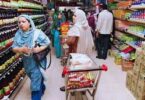Dr. Muhammad Shahid
The pandemic caused by the outbreak of corona virus has severely affected the global economy and Pakistan is no exception. The COVID-19 brought economic activities to a near-standstill. The speed of pandemic spread was alarming and affected millions. The policy response in the form of tight lockdowns and restrictions on mobility to stop the spread of the virus shrink economic activities.
We know that poor people in Pakistan are largely clustered around the poverty line and small negative shock can send significant percentage of the vulnerable population below poverty lines. There is a substantial reduction in economic growth due to COVID 19. Slow economic growth reversed years of progress towards poverty reduction, development goals and achievements of economic reforms. The reversal of economic fortunes pushed millions of people below poverty line.
The scale of economic damage can be assessed with great care to devise policies for the future. Unemployment at mass scale displaced millions that further worsened poverty and widened the gap between rich and poor. Every sector of the economy is affected by the COVID-19 including small and medium enterprises which has backward and forward linkages and is the major provider of employment opportunities to the people in the country. Globally unemployment increased to 220 million in 2020. Unemployment in Pakistan surged to 6.2 million in 2021. The closure of businesses due to negative supply shocks by disruption in the supply chain also contributed in sending additional 9 million people below poverty line in 2020-21. The effects of covid are disproportionate affecting men and women differently. The decline in employment for women is 5 percent which is higher than a reduction in employment for men that is 3.9 percent. Additionally 31 million people are added to extreme poverty. Along with women, the pandemic hit hard those who are not highly educated, trained, skilled and digitally rich.
Domestic mitigation measures and international restrictions adversely affected the domestic tourism sector added to unemployment and falling incomes due to which aggregate demand tumbled. Limited access to vaccines, refusal to vaccination due to false narratives and misleading information slow down the resumption of work in Pakistan.
Coming out of the pandemic, many countries are looking to drive outsize economic growth, not the incremental improvements. Countries are planning to allocate huge resources and invest in both tangible and intangible assets. Investment in intangible assets that underpin the knowledge or learning economy, such as investment in humans, allocating funds for research and development, invention and innovation and a deep focus on software has risen inexorably. The COVID-19 pandemic appears to have accelerated this shift from tangible assets or hardware to intangible assets or software and knowledge based economy.
The deepening economic crisis is not simple and therefore there is no magic bullet solution. A multipronged strategy is required that include multidimensional measures. First, Private sector is the engine of growth. Successful businesses drive growth, create jobs and pay the taxes that finance services and investment. In developing countries, the private sector generates 90 per cent of jobs, funds 60 per cent of all investments and provides more than 80 per cent of government revenues. The government should provide enabling environment and allow private sector to get flourish. Interventions to support private sector growth in the country should focus on home-grown businesses. The government can also encourage public private partnership to bring more and more investment in sectors including agriculture, construction, tourism, infrastructure, and the digital economy. But only growth is not sufficient. Making it more inclusive by distributing the benefits among masses is critical for shared prosperity.
Second, are we ready for a growth based on learning, knowledge, and intellectual capital based on quality human resources? As our economy rebounds, are we ready to invest in intangible assets to produce trained and skilled human capital to increase productivity and unlock more growth potential? Investment in humans is important to cater to the demands of the growing digital economy. This will also help to reduce inequality of opportunities by reducing the gap between those who are digitally rich and those who are digitally poor and deprived.
Third, pro-growth policies are required because economic growth is the prerequisite for generating employment. GDP growth rate of around 7 percent to 10 percent for at least two decades is required to generate approximately 1.5 million jobs for those who are entering the labor market. World Bank reports indicate that providing employment to the currently inactive and unemployed along with those entering labor markets requires more than two million jobs annually. Public investment in agriculture, particularly investment in those crops which have strong forward and backward linkages to promote industry based on agriculture. Public investment in housing infrastructure and tourism is also essential to spur growth in these sectors and generate employment and other economic opportunities for people.
Fourth, population plays a key role in development. Pakistan is the fifth most populous country in the world with population of more than 220 million people. Significant proportion of the population is young and around 63 percent of the country population aged between 15 and 33. UNDP report indicates that currently 64 percent of the nation is younger than 30 and 29 percent of Pakistanis are between 15 and 29. Pakistan now has more young people than it has ever had, and this is forecasted to continue to increase until at least 2050. We should not ignore the fact that youth have the power to transform a country’s future. Youth unemployment rate stood at 8.5 percent in Pakistan which is highest among the regional countries. Youth could be the engine of growth and development. But if this growing youth remain unattended, illiterate, untrained and unskilled, their disillusionment could lead to social unrest. So inclusion of the disadvantaged, marginalized and underprivileged young communities in the process of economic growth and development is the key to a prosperous society.
Fifth, Government can use the available research and data to get new insights for transforming the youth bulge into a demographic dividend. Before making any policy for generating employment, policy makers need to identify the drivers of change that can empower youth and harness their potential for human development. The famous three Es of the UNDP including Education, Employment and Engagement are the potential drivers of change. UNDP’s surveys and research identified that demographic dividend can be materialized by providing quality education, gainful employment, and meaningful engagement of the youth.
Sixth, sectorial analysis indicates that agriculture sector is characterized by low productivity. Agriculture sector also lack investment in value addition. Government should focus on agriculture-based industrialization to accommodate the low-skilled workforce. Public investment is required to support agriculture-led industrialization and to promote economic growth.
Seventh, challenges like twin deficits, fiscal and current account deficits and inflation make the environment more volatile and uncertain. Investors, both domestic and foreign, are reluctant to invest in Pakistan. Government should focus on stabilization policies by fixing the problem of budget deficit, reducing current account deficit and controlling inflation to ensure certain degrees of certainty.
Eight, the growth of businesses in any economy provides support to governments in addressing and overcoming economic challenges faced by the society like job creation and financial resources generation, and in improving the standard of living of the citizens. A high ease of doing business ranking means the regulatory environment is more conducive to the starting and operation of businesses in the country. Pakistan has consistently making efforts to improve business environment in the country. Since 2016, almost 300 reforms have been implemented to improve investment climate in the country. Resultantly, Pakistan improved 39 positions in EODB ranking in the last two years and was placed at 108th position. Initiatives to improve Doing Business Ranking will encourage investors to invest. Foreign direct investment will increase that will further stimulate private sector-led growth.
Besides the above suggestions and policy recommendations, we also need to address the challenge of inadequate public services to improve lives. Genuine economic reforms are crucial for making the economy more resilient and shock absorbing to set the stage for a lasting economic recovery and sustainable growth.






